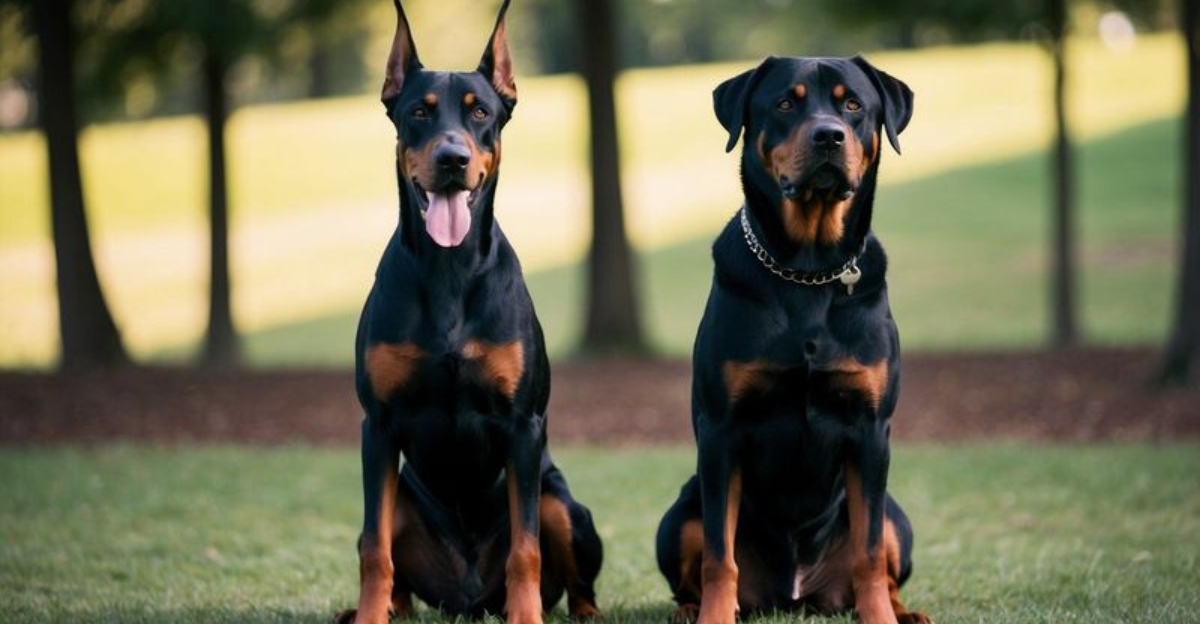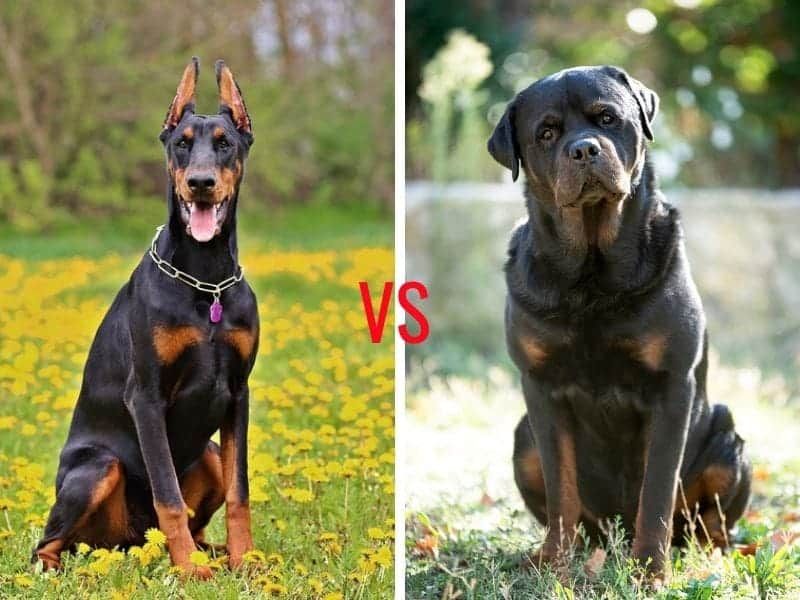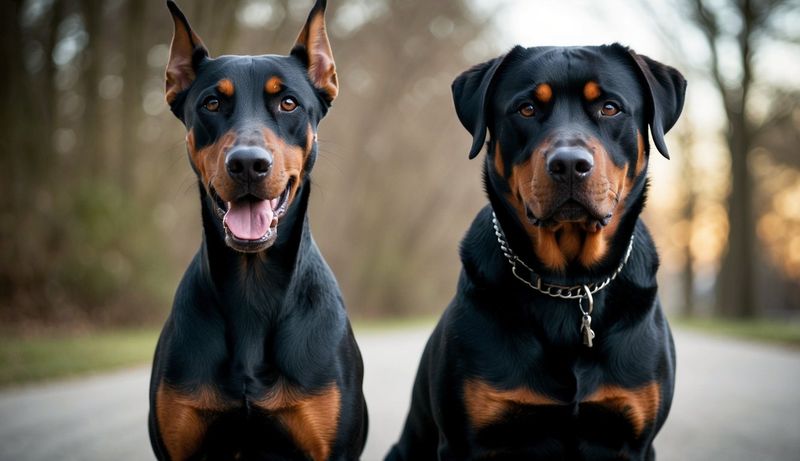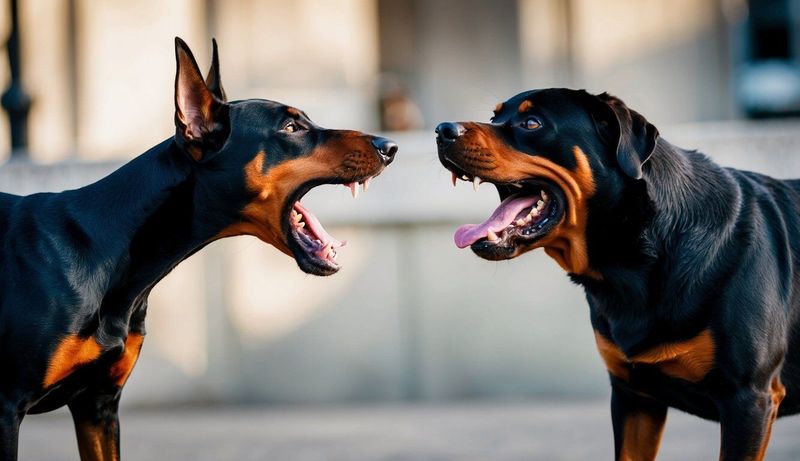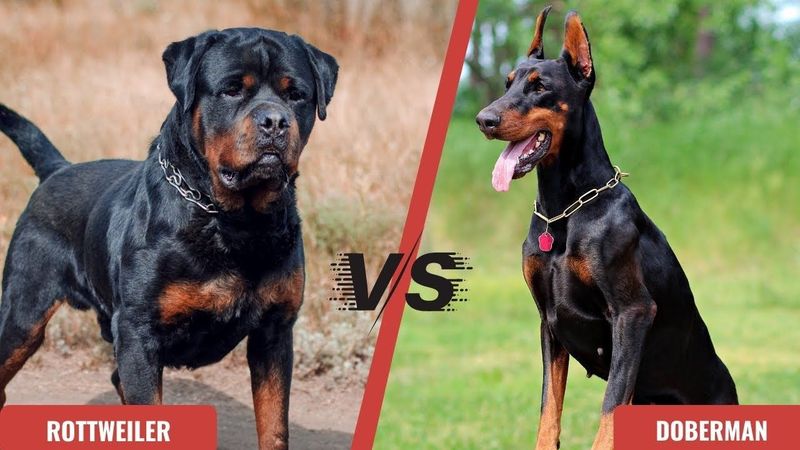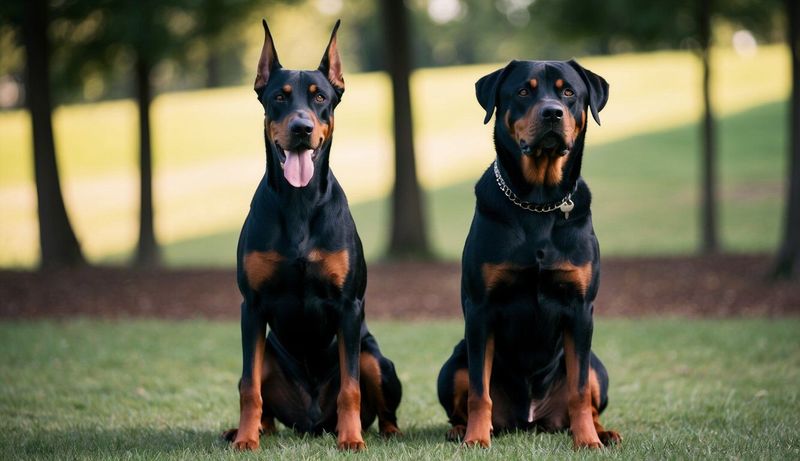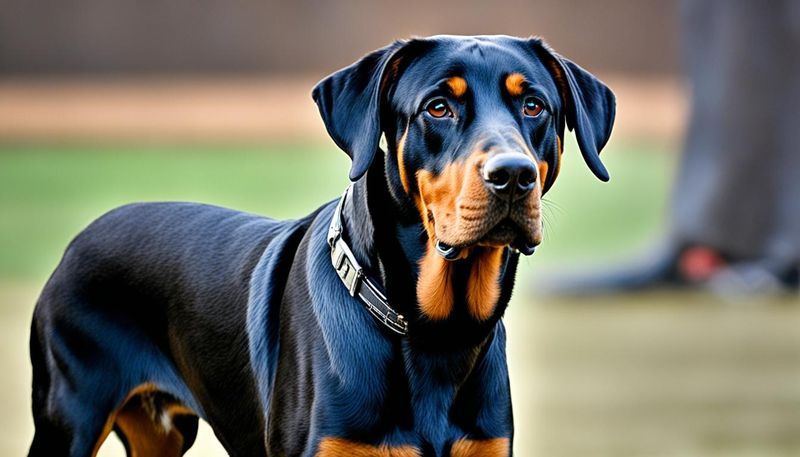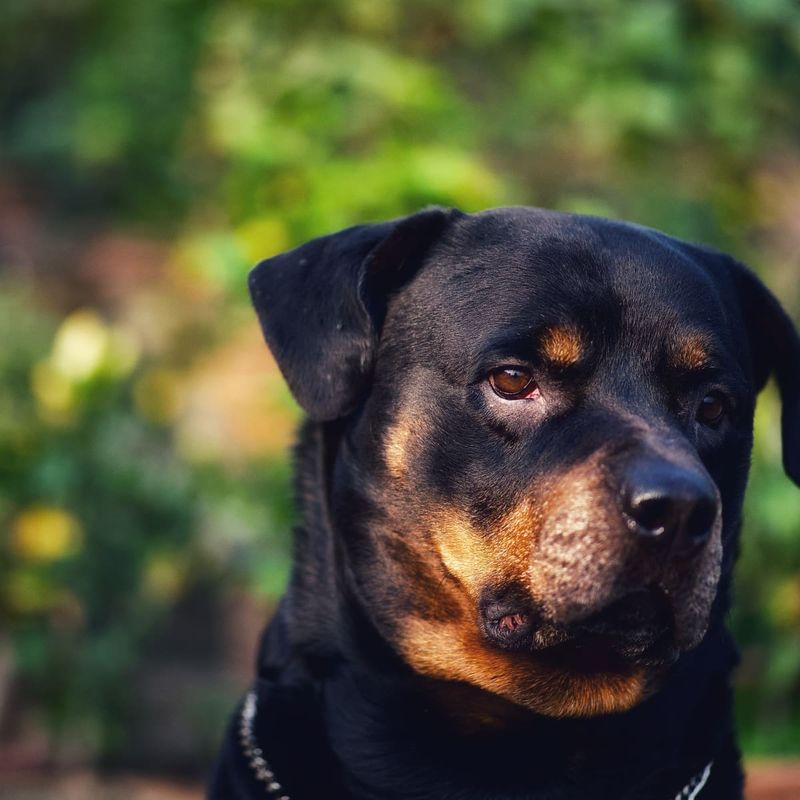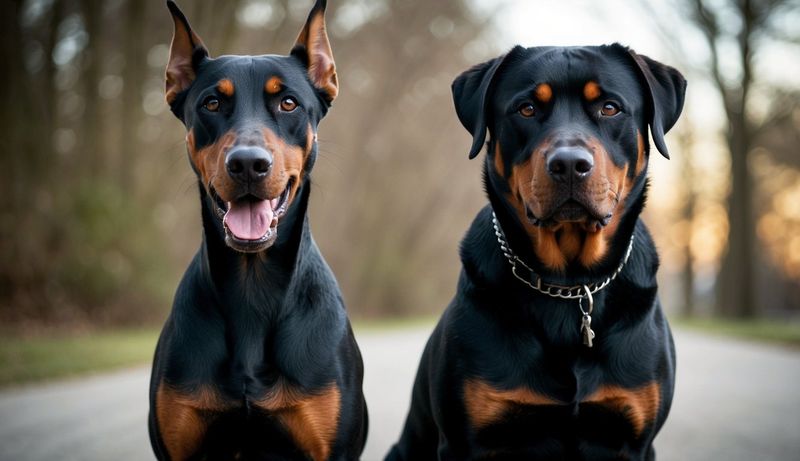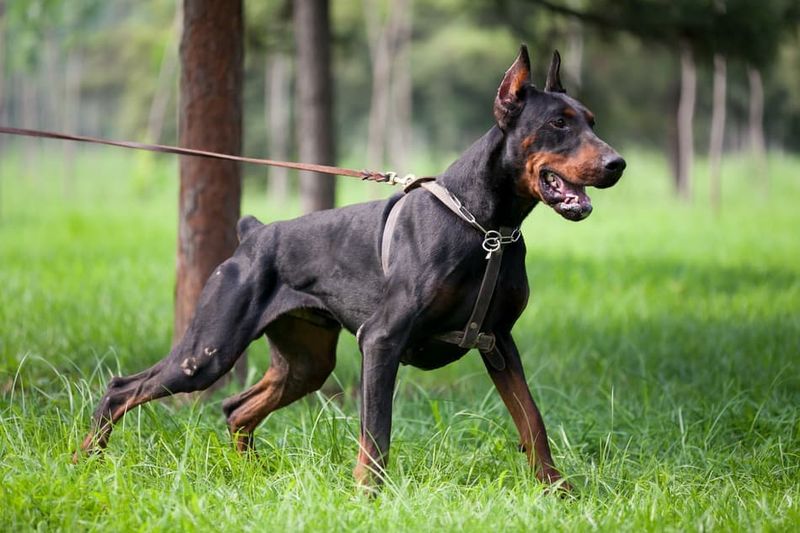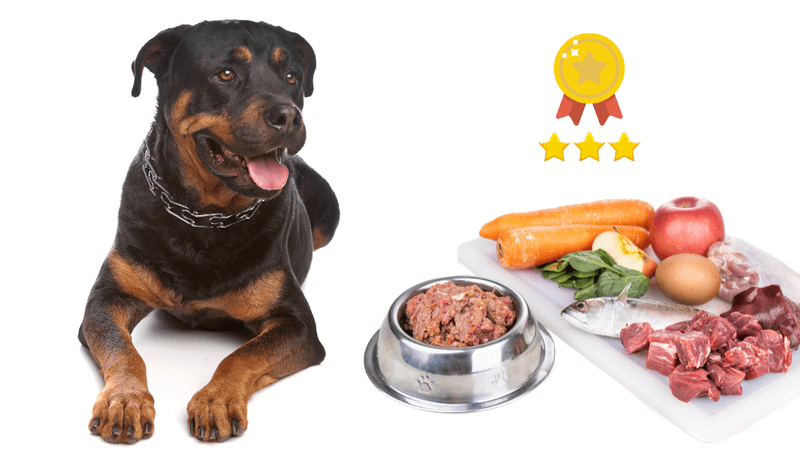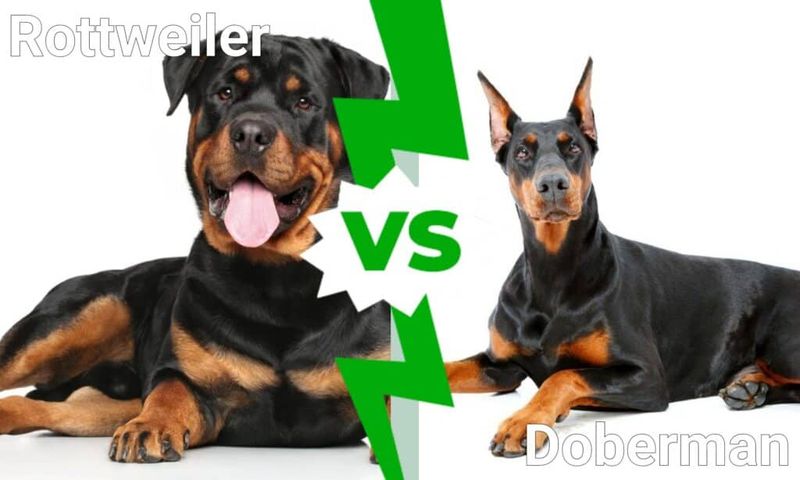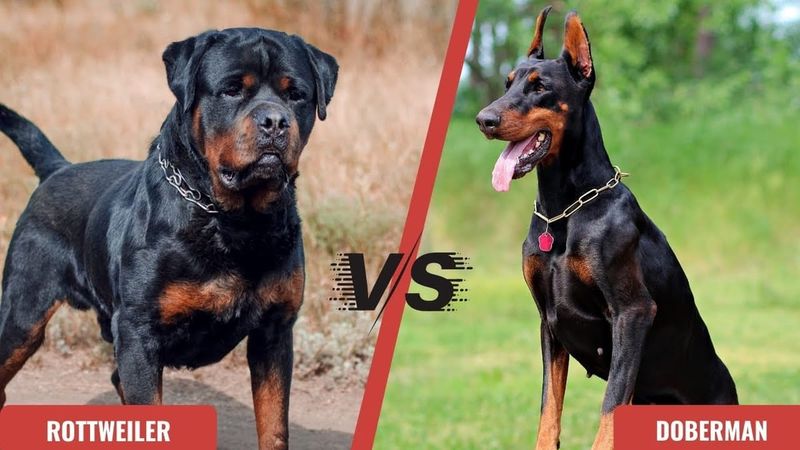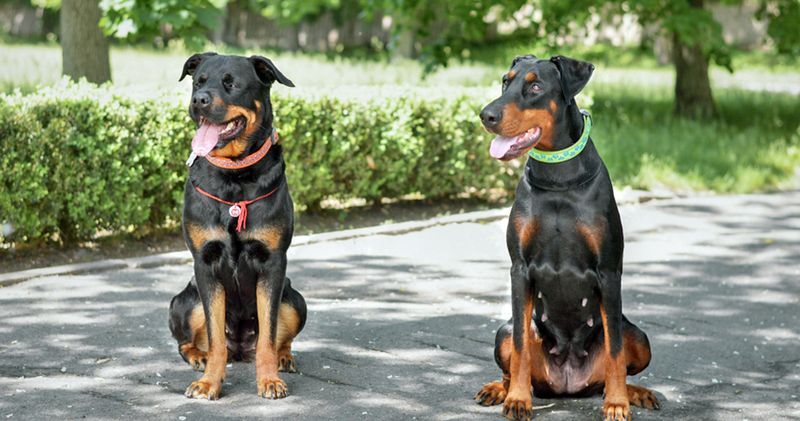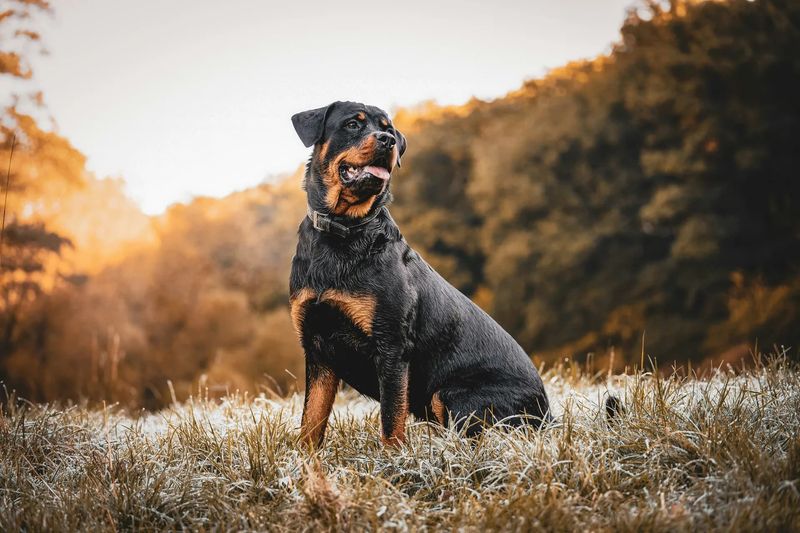Rottweilers and Dobermans, both renowned for their guarding capabilities, have distinct characteristics that set them apart. While both breeds possess formidable protective instincts, they exhibit differences in physical appearance, temperament, and training requirements. Exploring these unique traits can help potential dog owners make informed decisions on which breed suits their specific needs for a guard dog. This article delves into 18 key differences, providing a comprehensive comparison of these two impressive breeds.
Physical Appearance: Rottweilers Versus Dobermans
Rottweilers are known for their robust, muscular build, exuding strength and confidence. Their black and tan coats are distinct, with a more stocky frame compared to Dobermans. In contrast, Dobermans have a sleek, athletic physique, often with cropped ears and docked tails, which adds to their elegant appearance.
The Rottweiler’s imposing presence can be attributed to its broader chest and strong limbs, while the Doberman’s agility is highlighted by its streamlined body. Despite these differences, both breeds carry themselves with a regal demeanor, making them equally impressive as guard dogs.
Temperament: Loyalty and Affection
Rottweilers are often described as loyal companions, forming strong bonds with their families. Their affectionate nature belies their fierce protective instincts. On the other hand, Dobermans are known for their keen intelligence and unwavering loyalty.
While both breeds are devoted to their owners, Dobermans may exhibit more alertness and responsiveness to commands. This makes them highly effective guard dogs, capable of assessing situations quickly. The Rottweiler’s charm lies in its gentle demeanor with family, providing both protection and companionship.
Training Needs: Intelligence and Obedience
Dobermans are often praised for their intelligence, making them quick learners in training sessions. Their ability to grasp commands swiftly ensures they excel in obedience training, a crucial trait for guard dogs.
Rottweilers, while equally intelligent, require consistent and patient training methods to manage their strong-willed nature. They benefit from socialization classes to ensure a well-rounded temperament. Both breeds thrive under experienced handlers who can provide firm yet compassionate guidance. Proper training enhances their natural guarding instincts, making them reliable protectors.
Energy Levels: Active vs. Calm
When it comes to energy levels, Dobermans often display higher activity needs. They thrive on regular exercise, requiring ample space to run and play. This energetic disposition makes them well-suited for active families or individuals who enjoy outdoor activities.
In contrast, Rottweilers tend to have a more laid-back approach to life. They enjoy leisurely walks and moderate exercise but are equally content relaxing at home. Despite the differences, both breeds need regular activity to maintain their physical and mental well-being.
Guarding Instincts: Natural Protectors
Both Rottweilers and Dobermans possess strong guarding instincts, making them exceptional protectors. A Rottweiler’s guarding prowess is rooted in its history as a herding dog, showcasing a natural ability to protect its territory and loved ones.
Dobermans, bred specifically for protection, exhibit an innate alertness and keen sense for detecting potential threats. Their protective nature is coupled with quick reflexes, allowing them to respond swiftly to any dangers. Whether at home or on a patrol, these breeds are vigilant defenders, ensuring safety and security.
Socialization: Interaction with Strangers
Socialization plays a crucial role in defining a dog’s interaction with strangers. Rottweilers require early socialization to comfortably accept new people and environments. Their natural wariness can be tempered with positive experiences.
Dobermans, however, are known for their confident disposition and may be more accepting of strangers when properly socialized. This confidence enhances their ability to discern friend from foe, making them effective guard dogs. Both breeds benefit from consistent socialization to ensure balanced behavior and prevent undue aggression.
Family Compatibility: Kids and Pets
Rottweilers often exhibit patience and tolerance, making them suitable companions for families with children. Their gentle demeanor around kids is complemented by a protective attitude, ensuring a safe environment.
Dobermans, with their intelligent and loving nature, can also integrate well into family settings. They tend to form strong bonds with their human family members and can coexist peacefully with other pets when introduced appropriately. Both breeds require supervision around young children to ensure harmonious interactions.
Health Considerations: Common Issues
Health considerations are crucial when choosing a guard dog. Rottweilers are predisposed to certain health issues like hip dysplasia and obesity, requiring regular vet check-ups and a balanced diet.
Dobermans, on the other hand, are prone to heart conditions, such as dilated cardiomyopathy, necessitating vigilant health monitoring. Both breeds benefit from regular exercise and a healthy diet. Prospective owners should be aware of these common issues to ensure their pet’s long-term health and happiness.
History and Origin: Different Beginnings
Rottweilers boast a rich history, tracing back to Roman times where they served as herders and protectors. Their legacy as robust working dogs continues today, with their role evolving into formidable guard dogs.
Dobermans have a more recent origin, developed in the 19th century by Karl Friedrich Louis Dobermann in Germany. Bred specifically for protection, they quickly gained a reputation for their loyalty and guarding abilities. Understanding these historical backgrounds highlights the unique lineage and purpose of each breed.
Barking Tendencies: Vocal Guard Dogs
When it comes to vocal tendencies, Rottweilers may bark to alert their owners of unfamiliar presences, showcasing their protective instincts. Their bark is deep and commanding, effective in deterring potential intruders.
Dobermans, while capable of barking, often rely on their alert posture and presence to convey warnings. Their communication style is more subdued, preferring to reserve barking for significant threats. Both breeds serve as effective auditory and visual deterrents, enhancing their guarding capabilities.
Exercise Requirements: Staying Fit
Exercise is vital for both Rottweilers and Dobermans to maintain their physical and mental health. Rottweilers benefit from moderate exercise routines, including daily walks and play sessions. Their robust build requires activity to prevent weight gain.
Dobermans, with their high energy levels, require more rigorous exercise regimens. They enjoy running, agility training, and interactive play. Providing adequate exercise ensures both breeds remain fit, healthy, and mentally stimulated, crucial for their roles as guard dogs.
Dietary Needs: Nutritional Balance
Nutritional needs vary between Rottweilers and Dobermans. Rottweilers require a diet rich in protein and balanced in fats to support their muscular build and prevent obesity. Their diet should be monitored to avoid excessive weight gain.
Dobermans benefit from a nutrient-rich diet, focusing on heart health and maintaining their sleek physique. Adequate protein, vitamins, and minerals contribute to their overall well-being. Tailoring diets to their specific needs ensures both breeds maintain optimal health and vitality.
Protective Nature: Family versus Territory
Rottweilers are often characterized by their strong attachment to family, prioritizing the protection of loved ones. Their guarding instincts focus on providing a safe environment for their human companions.
In contrast, Dobermans exhibit a keen sense of territorial protection. They are vigilant about safeguarding their surroundings, making them exceptional guard dogs for property. Despite these differing focuses, both breeds are dedicated protectors, ensuring safety for family and home.
Adaptability: Urban and Rural Living
Adaptability is a key trait for both breeds. Rottweilers are versatile, thriving in suburban and rural settings where they can guard larger areas. Their robust nature allows them to adapt to various living conditions.
Dobermans, meanwhile, are well-suited to urban environments, provided they receive ample exercise. Their intelligence and trainability make them adaptable to city life, where they can protect smaller properties. Both breeds adjust well to different lifestyles, offering protection across diverse settings.
Popularity: Cultural Influence
The popularity of Rottweilers and Dobermans has been shaped by their roles in media and culture. Rottweilers often appear in films and television as powerful protectors, reinforcing their image as formidable guard dogs.
Dobermans, known for their sleek appearance, have also enjoyed time in the spotlight, featured prominently in movies and TV shows. Their portrayal as intelligent and loyal companions enhances their appeal. The cultural influence of both breeds underscores their status as iconic guard dogs.
Cost of Ownership: Investment Considerations
Owning a Rottweiler or Doberman involves financial considerations. Initial costs include purchasing or adopting, vaccinations, and microchipping. Rottweilers, with their larger size, may incur higher food expenses.
Dobermans, while similar in initial costs, may require investments in specialized training due to their high intelligence. Veterinary care, grooming, and accessories contribute to ongoing expenses for both breeds. Understanding these costs ensures potential owners are prepared for the financial responsibilities of owning a guard dog.
